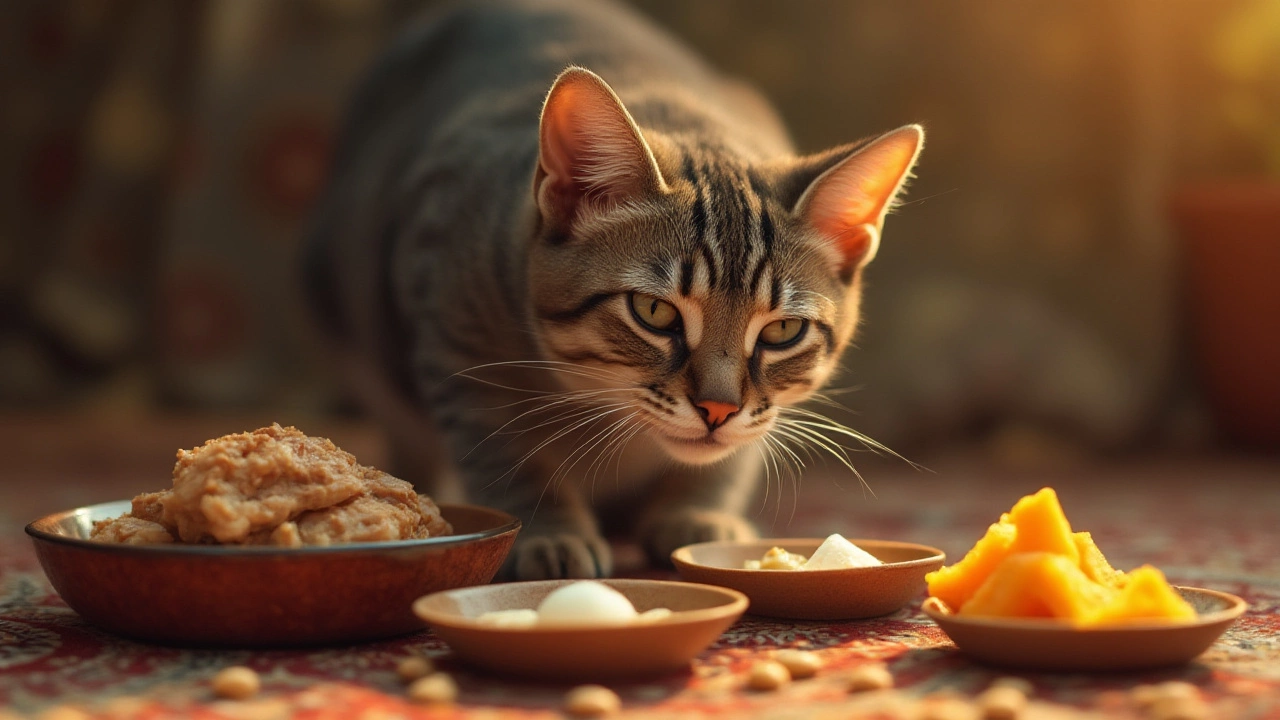
Ever stare at your cat’s dry food bowl and wonder if it looks a little… boring? It’s not just you. Plenty of cat parents start to question whether those nuggets are enough for a happy, healthy feline. Some cats even nudge their food around, stare at you, and act like you’re serving cardboard. So, is it smart or even safe to add anything to dry cat food?
What’s Actually in Commercial Dry Cat Food?
Those little brown kibbles promise a complete meal, but let’s peel back the layer. Most commercial dry food is designed to meet minimum nutritional requirements. You’re looking at a mix of animal protein (like chicken or fish meal), grains or starches (corn, rice, or peas), fat, fiber, essential vitamins, and minerals. Sounds decent, but here’s what’s missing: moisture. Dry food usually contains no more than 10% water, while cats naturally rely on moist prey for most of their hydration. That’s a big gap.
The other thing is protein quality. Cats are obligate carnivores, which means they need a lot of animal-based protein. Not all kibble delivers the same level of quality. The actual meat content varies wildly. Cheaper brands might boast chicken on the front, but show you "meat by-products" if you read the back. Also, carbs creep in. Manufacturers often use plant ingredients as fillers or binders, which cats digest less efficiently than animal proteins. Still, many brands use strict AAFCO (Association of American Feed Control Officials) guidelines to ensure nutrients hit the basics, but “basic” doesn’t mean ideal for every cat.
Let’s not forget flavor. Dry food is made palatable by spraying it with fats and flavors after it’s baked into nuggets. This process appeals to some cats but can turn off picky eaters or those used to canned or home-cooked meals. So, if your furball seems bored or just licks the gravy off wet food but shuns the crunchy bits, you’re definitely not alone.
| Component | Dry Food (%) | Wet Food (%) |
|---|---|---|
| Water | ~10 | ~75 |
| Protein | 30-40 | 8-12 |
| Fat | 10-20 | 2-6 |
Bottom line: Dry food is convenient and shelf-stable, but it can leave gaps, especially in hydration and sometimes in protein quality.
The Pros and Cons of Adding to Dry Cat Food
Let’s weigh the options. Why would you want to spritz, spoon, or mix anything into your cat’s standard chow?
- Hydration boost: Adding a splash of water or broth (low sodium, no onion/garlic) to dry food helps counteract its lack of moisture. Many indoor cats don’t drink enough water on their own, so extra moisture from food supports kidney health.
- More appetite appeal: Some cats get bored by dry food’s monotone texture. Toppers like a sprinkle of freeze-dried chicken, spoonful of wet food, or even a smidge of plain yogurt (if tolerated) can tempt finicky eaters.
- Increased nutrients: If your vet recommends, supplementing with canned pumpkin, unseasoned sardines (packed in water), or fish oil can help address fiber, omega-3, or vitamin shortfalls.
Problems arise if you add foods that aren’t cat-safe, turn the meal into a high-calorie bomb, or upset the balanced nutrition of the original kibble. Onions, garlic, grapes, raisins, chocolate—these can be toxic for cats, even in small amounts. Dairy is tricky. Although some adult cats handle tiny amounts of plain yogurt, most are lactose intolerant. And too much fish (especially tuna) messes with vitamin E and can overload mercury.
Another risk: portion creep. Adding treats, toppers, or extra fat can quickly push your cat into overweight territory. That means more risk for diabetes, joint trouble, and even urinary tract issues—problems no cat parent wants. The key here is moderation, and when in doubt, talk to your vet about your specific cat’s body condition and health quirks.
Best (and Worst) Additions to Cat Dry Food
So, what are your best options for making dry food more nutritious and tempting—without messing up your cat’s health?
- Water or diluted broth: Simple, cheap, and perfect for hydration. Go for low-sodium chicken, beef, or bone broth. Never use anything with onions, garlic, or heavy seasoning.
- Plain, canned pumpkin (not pie filling): Adds fiber, helps digestion, and most cats handle a teaspoon mixed into food well.
- Freeze-dried meat toppers: Chicken, turkey, salmon—single ingredient and easy to find. These are packed with protein and flavor, with no extra carbs or fillers.
- Canned, unsalted sardines or tuna (in water): A super-occasional treat. Offers a hit of omega-3s and protein, but don’t overdo it because of possible mercury and salt.
- High-quality wet cat food: Mixing a spoonful or two into dry food boosts hydration, protein, and taste, especially for senior cats.
- Fish oil (from trusted pet sources): A few drops gives extra omega-3 fatty acids, which help skin, coat, and joints.
Now, the big no-nos:
- Anything with onions, chives, garlic, or leeks (in any form).
- Chocolate, caffeine, grapes, raisins, or avocado.
- Processed deli meat, sausage, or bacon (too salty, often spiced or cured).
- Dairy (for most adults, causes stomach upset).
- Excessive carb-based foods (breads, cereals), which cats can’t digest well.
All these options work best in rotation and in small amounts. Cats are creatures of habit but still appreciate new scents, flavors, and textures. Just watch them for signs of food intolerance (vomiting, diarrhea, lethargy) anytime you try something new, especially if your cat has a medical condition or special diet.

Tips for Trying Something New
If you want to experiment, do it right. Start with a very small amount—think half a teaspoon—mixed thoroughly into the food. Observe not just whether your cat eats it, but if there’s any change in litter box action, energy, or mood.
- Talk to your vet: Especially if you’re considering big changes or if your cat is a kitten, senior, or on prescription food. They can help rule out allergies, sensitivities, or underlying conditions.
- One addition at a time: If things go awry (vomiting, diarrhea), you want to be able to figure out the culprit quickly.
- Hydration first: If your cat’s main issue is low water intake, start by just adding filtered water or broth to kibble, rather than jumping to more caloric toppers.
- Don’t force it: If your cat sniffs and walks away, respect their taste. Most cats don’t appreciate sudden big changes or strong flavors.
- Watch the calories: Additions are nice, but the nutrition in commercial cat food is already complete. Everything else is a bonus treat, not a replacement or mainstay, unless advised by your vet.
Some folks use interactive feeders or puzzle toys to make dry food more interesting. These slow down eating and engage your cat’s brain—win-win if dealing with a couch potato or food obsessive.
If you’re seeing common health issues like dry skin, dull coat, hairballs, or constipation, sometimes a diet tweak (like adding fiber or healthy fats) can help, but other times it’s a sign you need a vet check. Bloodwork, urine tests, or a full check-up will rule out chronic kidney disease, diabetes, or hyperthyroidism—common in adult and senior cats.
When Should You Skip the Additions Altogether?
There are times when it’s best to stick strictly to the bag’s instructions. Prescription diets for chronic kidney diseases, urinary tract issues, or allergies are carefully balanced, and outside additions can ruin the effect or even cause harm.
Cats with food allergies or sensitive stomachs do best with a single, well-tolerated recipe—usually hydrolyzed protein or limited ingredient diets. For these felines, adding pumpkin, fish, or broth could trigger vomiting, diarrhea, or itchy skin.
Weight management formulas are also carefully calculated. Throwing extra protein or fat on top can sabotage weight loss goals and even hurt metabolism or organ function. Same goes for kittens under 12 months—they need special, calorie-dense diets. Add-ins can upset the balance.
If you have multiple cats and one is on a medical diet, feeding separate meals in different rooms is smarter than trying to top up everybody’s bowl. Individual plans are safer and fairer.
Finally, if you’re worried about cost or complexity, don’t stress. Doing nothing is still a totally valid choice for most adult cats on a complete, balanced dry food. The real harm comes from overdoing it or believing that every meal needs a fancy flair.
How to Make Your Cat’s Mealtime More Satisfying—Without Compromising Health
Turns out, the way you serve food counts just as much as the food itself. Use wide, shallow bowls—cats hate it when their whiskers are crushed. Keep water bowls in another spot, since cats prefer “hunting” for water sources away from food stashes.
Rotate protein flavors every bag or two to fight food boredom, but do it gradually, mixing old and new kibble over several days. This can help stave off food allergies and fussy eating habits later.
Try food puzzles. They slow eating, prevent scarf-and-barf, and let cats “hunt” indoors. Hide a few kibbles in a cardboard egg carton, or buy treat balls and slow-feeders. This is an easy way to add mental stimulation, especially for bored indoor cats.
Get creative with presentation—a scoop of wet food hidden under dry, a different bowl every so often, or even “treasure hunts” with hidden snacks. All these options add excitement without swapping ingredients or risking nutrition.
- If you have more than one cat, give each a private eating space. Cats naturally eat alone and will feel less stressed about competition.
- Keep things clean. Wash bowls daily with warm water and mild soap—old kibble oils go rancid fast and can actually put cats off their dinner.
- Don’t leave dry food out for days. Not only does it lose scent and crunch, but it can attract bugs and go stale, which your whiskered friend will definitely notice.
If your cat’s not showing signs of boredom or health issues, and they seem happy and energetic, there’s no “must” to adding extras. But if you want to boost hydration, give variety, or encourage picky eaters, a little thoughtful topping (in moderation, with safe foods!) can give you both more peace of mind—and maybe an enthusiastic purr at dinnertime.
